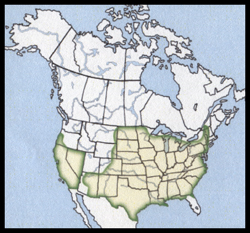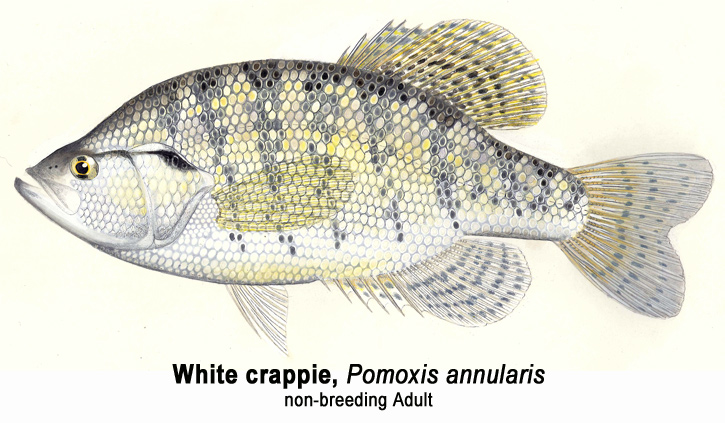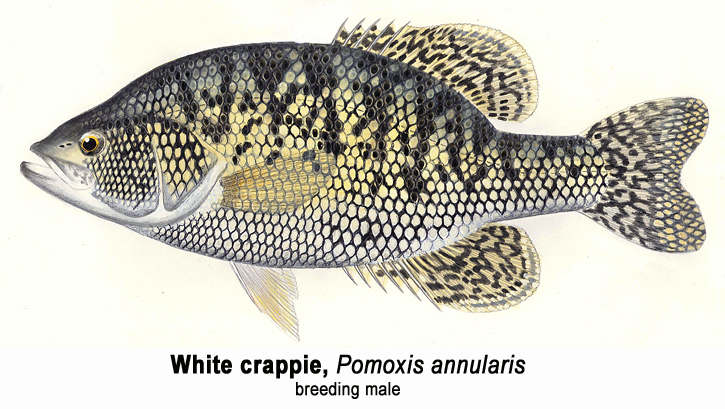White Crappie, July 2015, Fish of the Month!
White crappie
Pomoxis annularis
Local Names:
Papermouth, Tinmouth, Barfish, Crappie, Silver perch, White perch, Cambellite, Gold ring
Average Size:
10 to 12 inches
½ to 3/4 pound
Distinguishing Field Marks:
(See the illustration.)
-
The body is moderately deep, slab-sided.
-
The dorsal fin has 6 spines.
-
The of the top of the head is distinctly concave.
The eye is large.
The mouth is of moderate size with its upper jaw extending backwards to the rear edge of the eye.
There is a small dark spot on the trailing edge of the gill covers.
The anal fin has 5 spines and is equal in length to the dorsal fin.
North American Range:
Map to the right shows approximate range in North America.
Diet:
Young White crappie feed heavily on aquatic invertebrates, especially crustaceans. Adults feed on immature (and occasionally adult) aquatic insects, and crustaceans. A significant portion of the adults' diet is made up of small fishes.
Biology:
White crappie spawn in late spring and early summer over a period of about a month's time. The spawning activity is typical of the small sunfishes, however this species tends to spawn in somewhat deeper water than the other members of its tribe. The males clear but do not dig nest sites that are usually very close to or include vegetation and algae. The nests may be either solitary or in colonies but are never well defined in their shape. When they are ready to spawn, the females approach the highly territorial nest-site-defending males and are courted by them. The pairs then enter the nests and with little fanfare begin releasing very small batches of eggs and milt in as many as 50 matings. Ripe females carry an average of 25,000 to 60,000 eggs. When fertilized, the eggs are adhesive and attach to the bottom of the nest or vegetation. The male parent remains at the nest fanning the eggs to aerate them as they incubate for an average of 4 days. The newly hatched young remain dormant in the nest as they absorb the yolk sac for an additional 4 days. After that, when they have become fully active, White crappie fry soon begin to leave the nest. The males abandon the nest sites as soon as their broods have departed.
As adults, White crappie are very fond of sheltering in brush-piles or in or close to rooted vegetation. They thrive in moderately turbid, silted water, and are typically found in slow moving streams, the quiet portions of larger rivers, small ponds and lakes, or impoundments.
Fly Fishing for White crappie:
As stated above, this species is most often found in shallow, often moderately turbid waters where there is ample shoreline protection in the form of fallen logs, brush-piles and aquatic vegetation. Nevertheless, they will school in more open water in search of food and can often be seen circling and rising to the surface, especially in calm late day or early morning conditions.
Fly rodders will find 5 or 6 weight equipment best suited to presenting their offerings to these soft-mouthed sunfish. Standard or slow-sinking short sink-tip lines are suggested. As previously mentioned, White crappie do occasionally form loose schools and feed actively at the water's surface. However, only a small portion of their normal diet is found there. Their dietary preference for small forage fish makes lightly weighted flies tied in a variety of bright colors your go-to choices. Most of these flies more closely resemble jigs than classic dry or wet flies. Their basic form is very similar to that of the world famous Wooly Bugger. If you don't tie your own flies you can cob together an assortment of commercially tied flies ( make an internet search for the best patterns) that may or may not be designed for crappie fishing. If you do tie flies, and are new to this form of our favorite outdoor activity, you're likely to have plenty of fun designing and tying your own crappie flies based on some standard crappie fly patterns (again, use the internet to find these).
White crappie are not strong battlers but are plenty of fun to catch because they are often very willing to take our offerings. Once hooked though, they must be gently played to prevent tearing the hook from their soft mouths.
Significance to Humans:
Because their meat is very sweetly flavorful this species is nearly always consumed by the anglers who catch it. However, it may occasionally appear as fresh fish in local markets. Throughout its range the White crappie is primarily considered to be a game fish species rather than a food fish. It continues to support a loyal following of anglers.
Status:
Maintaining, mainly (but not exclusively) through natural reproduction, and thriving in favorable habitats.








